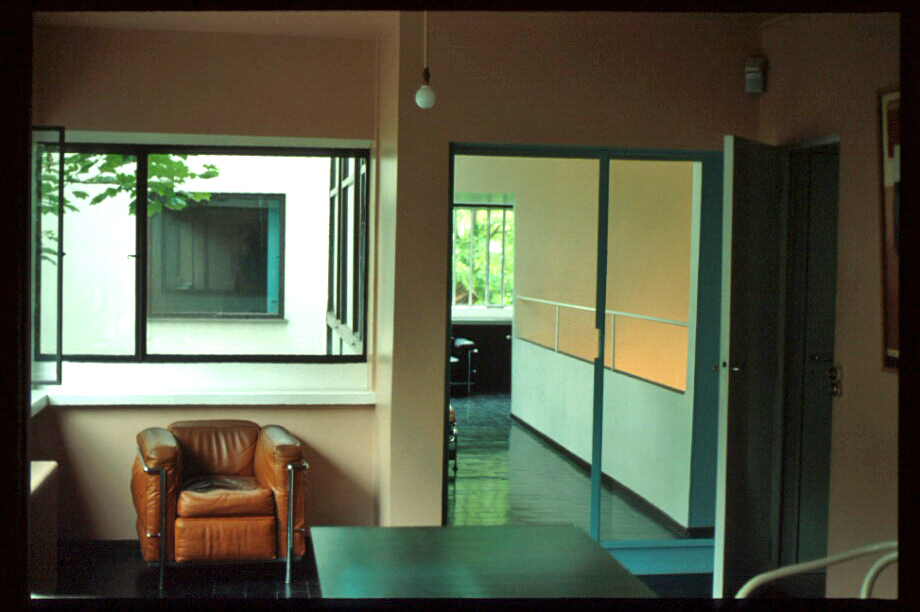Social Norms and Habits for Buildings
It is important to recognize the way social norms govern our engagement with architecture. We identify a building as for a certain purpose. We act and hold our bodies differently in a courtroom or a church than in our living room or at a park. Those norms are passed along over time, and they can change, though usually they change slowly. For the most part, these norms are taken for granted, shaping the background for our activities.
Arakawa and Gins want what they call the architectural surround to have the odd combination of being a background for other activities yet also being obtrusive and demanding new kinds of bodily engagement.

Bioscleave House (image courtesy of Joke Post/Arakawa+Gins).
There is a danger that Arakawa and Gins's complex architectural surrounds will lose their effect over time as habituation reduces them to a familiar environment with familiar difficulties that get overcome automatically by habit. I have written about this danger elsewhere (1).
In this essay, though, I want to discuss a different danger, that without new social norms and arrangements that encourage engagement, and new sites for that engagement, their kind of architecture would remain like a museum exhibition, an occasional foreground holiday or experimental lark, and could not have a continuing influence on bodily inhabitation. Their buildings need to be more available and to be approached within social practices that define them as for daily life rather than as for an exciting exception from daily life.
For example Arakawa and Gins's Yoro park in Japan (2) is socially defined as an extraordinary space where one concentrates on orienting oneself and experiencing the park and its novelties. The contortions of the space and its contents are the primary focus. One goes to experience this as uniquely different, not to live in it as one would in a "normal" park, going for picnics, playing ball, watching the children. When we visited Yoro we were one of perhaps four couples in the large expanse. The overall effort was towards solitary and bemused contemplation plus physical exertion. It was an experience akin to visiting a museum, where works of art are enshrined for an experience which is defined as different from everyday life, providing moments that may help illuminate everyday life but which do not remain present.
An apartment building or to a lesser extent a hotel designed along the lines of their Mitaka lofts in Japan (3) or the Bioscleave House on Long Island (4) would be places socially defined as to be experienced in the activities of daily living rather than themselves being the focus of attention. But as yet Arakawa and Gins have been able to produce mostly demonstration projects, experiments, which are not socially accepted as part of ordinary daily lives.
Besides making their architecture more available as surroundings for daily life, there also need to be new social norms which encourage people to live their daily lives in such "difficult" spaces. Arakawa and Gins want our lives, which typically concentrate on their aims and rituals while making architectural surrounds a neutral background, be confronted by an architecture which will not let go, spaces that demands self-conscious bodily engagement and work procedures on our bodies and perceptions. For their architecture to achieve its desired effects, there would have to be a combination of new architectural surrounds available for daily life plus a social definition that these surroundings are for more than occasional stimulating adventures. It would take not just new buildings but also changes in social norms to make Arakawa and Gins's experiments more than experimental.
Recognizing this problem, Arakawa and Gins have been trying to bring about such new social norms through their campaign against dying. "Making dying illegal" includes a plea for new social definitions and norms that would require their kind of architecture to be built and lived in (5). They are trying to open up the possibility of their architecture being used on a daily basis by large numbers of people. The full implementation of the "making dying illegal" program would make it a necessity for everyone.
In this, Arakawa and Gins share the the modernist dream of shaping life anew and making their kind of architecture unavoidable.

The interior of le Corbusier's Villa la Roche outside of Paris.
In this they closely parallel the demands made by Le Corbusier for a new mode of building that would correspond to what he saw as the dawning modern mode of life (6). In both cases the architect is attempting to redefine both how one builds and how one lives in buildings. In his rhetoric Le Corbusier says that the new norms are already present and architecture needs to catch up with society and industry. He exaggerates the change already happening; his examples of streamlined wonders demonstrate a possible mode of life more than showing already actual social norms. But he was right that economics and industry were pushing us into new modes of life.
Arakawa and Gins do not have that kind of impersonal economic impetus behind their architecture. Yet it is true that in recent years there has been greater emphasis on healthy living, on bodily care and training, and more willingness to try unexpected and "foreign" exercises and diets. Feng Shui has become more prominent, and architects are becoming more attuned to studies in environmental psychology. People are more accustomed to the idea that their architectural surrounds may be influencing, for good or bad, their body, energy, and physical possibilities, as well as their psychological well-being. Such changes may make people more open to new social norms that might lead to importing some aspects of Arakawa and Gins's larger designs into everyday spaces.
Inserting bits of Arakawa and Gins designs into already built ordinary spaces would parallel the way Le Corbusier and other early modernist architects began to design furniture and accessories, thus affecting public taste and encouraging new behaviors. It is not accidental that the classic modernists such as Le Corbusier, Frank Lloyd Wright, and Mies van der Rohe strove for total control of one's environment. What seemed dictatorial was part of their effort to change social norms and habits.
Arakawa and Gins' architecture would benefit new social norms that encourage people to live daily life in their difficult and ambiguous spaces. But it would be more accurate to say that what would benefit their work would be the collision of multiple social norms. The activities of daily life would go on, defined by their usual norms and requirements. But cross-cutting and challenging them would be the norms of mindfulness, bodily care, and a new precision that enriches daily routines. That creative collision of norms and habits would itself stimulate awareness and change lives.
